Data-Driven Load Forecasting of Air Conditioners for Demand Response Using Levenberg–Marquardt Algorithm-Based ANN
Abstract
:1. Introduction
2. Big Data Analysis in Power Systems
3. AC Demand and Load Forecasting
4. LMA-based ANN Approach
5. Performance Assessment Indices
6. Case Studies
7. Conclusions
Author Contributions
Funding
Conflicts of Interest
References
- Garcia-Valle, R.; Silva, L.C.P.D.; Xu, Z.; Ostergaard, J.J. Smart demand for improving short-term voltage control on distribution networks. IET Gener. Transm. Distrib. 2009, 3, 724–732. [Google Scholar] [CrossRef] [Green Version]
- Paridari, K.; Nordstrom, L.; Sandels, C. Aggregator strategy for planning demand response resources under uncertainty based on load flexibility modeling. In Proceedings of the 2017 IEEE International Conference on Smart Grid Communications (SmartGridComm), Dresden, Germany, 23–27 October 2017; pp. 338–343. [Google Scholar]
- De Cian, E.; Wing, I.S. Global energy consumption in a warming climate. Environ. Resour. Econ. 2019, 72, 365–410. [Google Scholar] [CrossRef]
- Santamouris, M.; Sfakianaki, A.; Pavlou, K. On the efficiency of night ventilation techniques applied to residential buildings. Energy Build. 2010, 42, 1309–1313. [Google Scholar] [CrossRef]
- Ahmad, M.I.; Jarimi, H.; Riffat, S. Introduction: Overview of Buildings and Passive Cooling Technique. In Nocturnal Cooling Technology for Building Applications; Springer: Berlin, Germany, 2019; pp. 1–6. [Google Scholar]
- Malik, A.; Haghdadi, N.; MacGill, I.; Ravishankar, J. Appliance level data analysis of summer demand reduction potential from residential air conditioner control. Appl. Energy 2019, 235, 776–785. [Google Scholar] [CrossRef]
- Borlase, S. Smart Grids: Infrastructure, Technology, and Solutions; CRC Press: Boca Raton, FL, USA, 2016. [Google Scholar]
- Conti, J.; Holtberg, P.; Diefenderfer, J.; LaRose, A.; Turnure, J.T.; Westfall, L. International Energy Outlook 2016 with Projections to 2040; USDOE Energy Information Administration (EIA): Washington, DC, USA, 2016.
- Haider, H.T.; See, O.H.; Elmenreich, W. A review of residential demand response of smart grid. Renew. Sustain. Energy Rev. 2016, 59, 166–178. [Google Scholar] [CrossRef]
- Shao, C.; Ding, Y.; Siano, P.; Lin, Z. A framework for incorporating demand response of smart buildings into the integrated heat and electricity energy system. IEEE Trans. Ind. Electron. 2019, 66, 1465–1475. [Google Scholar] [CrossRef]
- Siano, P.; Sarno, D. Assessing the benefits of residential demand response in a real time distribution energy market. Appl. Energy 2016, 161, 533–551. [Google Scholar] [CrossRef]
- Swan, L.G.; Ugursal, V.I. Modeling of end-use energy consumption in the residential sector: A review of modeling techniques. Renew. Sustain. Energy Rev. 2009, 13, 1819–1835. [Google Scholar] [CrossRef]
- Bourdeau, M.; Zhai, X.-Q.; Nefzaoui, E.; Guo, X.; Chatellier, P. Modelling and forecasting building energy consumption: A review of data-driven techniques. Sustain. Cities Soc. 2019. [Google Scholar] [CrossRef]
- Cai, H.; Shen, S.; Lin, Q.; Li, X.; Xiao, H. Predicting the energy consumption of residential buildings for regional electricity supply-side and demand-side management. IEEE Access 2019, 7, 30386–30397. [Google Scholar] [CrossRef]
- Zhou, B.; Li, W.; Chan, K.W.; Cao, Y.; Kuang, Y.; Liu, X.; Wang, X. Smart home energy management systems: Concept, configurations, and scheduling strategies. Renew. Sustain. Energy Rev. 2016, 61, 30–40. [Google Scholar] [CrossRef]
- Hu, M.; Xiao, F. Price-responsive model-based optimal demand response control of inverter air conditioners using genetic algorithm. Appl. Energy 2018, 219, 151–164. [Google Scholar] [CrossRef]
- Chen, M.; Mao, S.; Liu, Y. Big data: A survey. Mob. Netw. Appl. 2014, 19, 171–209. [Google Scholar] [CrossRef]
- Soliman, S.A.; Al-Kandari, A.M. Electrical Load Forecasting: Modeling and Model Construction; Elsevier: Amsterdam, The Netherlands, 2010. [Google Scholar]
- Ye, C.J.; Ding, Y.; Wang, P.; Lin, Z. A Data-driven Bottom-up Approach for Spatial and Temporal Electric Load Forecasting. IEEE Trans. Power Syst. 2019, 34, 1966–1979. [Google Scholar] [CrossRef]
- Koseleva, N.; Ropaite, G. Big data in building energy efficiency: Understanding of big data and main challenges. Procedia Eng. 2017, 172, 544–549. [Google Scholar] [CrossRef]
- Khan, A.R.; Razzaq, S.; Alquthami, T.; Moghal, M.R.; Amin, A.; Mahmood, A. Day ahead load forecasting for IESCO using Artificial Neural Network and Bagged Regression Tree. In Proceedings of the 2018 1st International Conference on Power, Energy and Smart Grid (ICPESG), Mirpur, Pakistan, 12–13 April 2018; pp. 1–6. [Google Scholar]
- Osman, A.M.S. A novel big data analytics framework for smart cities. Future Gener. Comput. Syst. 2019, 91, 620–633. [Google Scholar] [CrossRef]
- Elgendy, N.; Elragal, A. Big data analytics: A literature review paper. In Proceedings of the Industrial Conference on Data Mining, St. Petersburg, Russia, 16–20 July 2014; pp. 214–227. [Google Scholar]
- Shim, J.P.; French, A.M.; Guo, C.; Jablonski, J. Big Data and Analytics: Issues, Solutions, and ROI. CAIS 2015, 37, 39. [Google Scholar] [CrossRef]
- Akhavan-Hejazi, H.; Mohsenian-Rad, H. Power systems big data analytics: An assessment of paradigm shift barriers and prospects. Energy Rep. 2018, 4, 91–100. [Google Scholar] [CrossRef]
- Yu, N.; Shah, S.; Johnson, R.; Sherick, R.; Hong, M.; Loparo, K. Big data analytics in power distribution systems. In Proceedings of the 2015 IEEE Power & Energy Society Innovative Smart Grid Technologies Conference (ISGT), Washington, DC, USA, 17–20 February 2015; pp. 1–5. [Google Scholar]
- Zhang, D.; Qiu, R.C. Research on big data applications in Global Energy Interconnection. Glob. Energy Interconnect. 2018, 1, 352–357. [Google Scholar]
- Grolinger, K.; L’Heureux, A.; Capretz, M.A.; Seewald, L. Energy forecasting for event venues: Big data and prediction accuracy. Energy Build. 2016, 112, 222–233. [Google Scholar] [CrossRef]
- Hong, T. Big data analytics: Making the smart grid smarter. IEEE Power Energy Mag. 2018, 16, 12–16. [Google Scholar] [CrossRef]
- Pérez-Chacón, R.; Luna-Romera, J.; Troncoso, A.; Martínez-Álvarez, F.; Riquelme, J. Big data analytics for discovering electricity consumption patterns in smart cities. Energies 2018, 11, 683. [Google Scholar] [CrossRef]
- Wang, P.; Liu, B.; Hong, T. Electric load forecasting with recency effect: A big data approach. Int. J. Forecast. 2016, 32, 585–597. [Google Scholar] [CrossRef] [Green Version]
- Davis, L.W.; Gertler, P.J. Contribution of air conditioning adoption to future energy use under global warming. Proc. Natl. Acad. Sci. USA 2015, 112, 5962–5967. [Google Scholar] [CrossRef] [PubMed] [Green Version]
- Gungor, V.C.; Sahin, D.; Kocak, T.; Ergut, S.; Buccella, C.; Cecati, C.; Hancke, G.P. A survey on smart grid potential applications and communication requirements. IEEE Trans. Ind. Inform. 2012, 9, 28–42. [Google Scholar] [CrossRef]
- Sivak, M. Potential energy demand for cooling in the 50 largest metropolitan areas of the world: Implications for developing countries. Energy Policy 2009, 37, 1382–1384. [Google Scholar] [CrossRef]
- Santamouris, M. Cooling the buildings–past, present and future. Energy Build. 2016, 128, 617–638. [Google Scholar] [CrossRef]
- Kim, D.H.; Yoon, Y.T.; Lee, S.S.; Lee, S.K. Power system restoration plan using the characteristics of scale-free networks. Eur. Trans. Electr. Power 2008, 18, 809–819. [Google Scholar] [CrossRef]
- Hong, T. Short-Term Electric Load Forecasting. Available online: https://www.researchgate.net/publication/279683748_Short_Term_Electric_Load_Forecasting (accessed on 12 May 2019).
- Singh, A.K.; Khatoon, S.; Muazzam, M.; Chaturvedi, D. Load forecasting techniques and methodologies: A review. In Proceedings of the 2012 2nd International Conference on Power, Control and Embedded Systems, Allahabad, India, 17–19 December 2012; pp. 1–10. [Google Scholar]
- Campbell, S.D.; Diebold, F.X. Weather forecasting for weather derivatives. J. Am. Stat. Assoc. 2005, 100, 6–16. [Google Scholar] [CrossRef]
- Xie, J.; Hong, T. Load forecasting using 24 solar terms. J. Mod. Power Syst. Clean Energy 2018, 6, 208–214. [Google Scholar] [CrossRef] [Green Version]
- Pedro, H.T.; Coimbra, C.F. Assessment of forecasting techniques for solar power production with no exogenous inputs. Sol. Energy 2012, 86, 2017–2028. [Google Scholar] [CrossRef]
- Li, Y.; Su, Y.; Shu, L. An ARMAX model for forecasting the power output of a grid connected photovoltaic system. Renew. Energy 2014, 66, 78–89. [Google Scholar] [CrossRef]
- Bessa, R.J.; Trindade, A.; Silva, C.S.; Miranda, V. Probabilistic solar power forecasting in smart grids using distributed information. Int. J. Electr. Power Energy Syst. 2015, 72, 16–23. [Google Scholar] [CrossRef] [Green Version]
- Raza, M.Q.; Khosravi, A. A review on artificial intelligence based load demand forecasting techniques for smart grid and buildings. Renew. Sustain. Energy Rev. 2015, 50, 1352–1372. [Google Scholar] [CrossRef]
- Abdel-Nasser, M.; Mahmoud, K. Accurate photovoltaic power forecasting models using deep LSTM-RNN. Neural Comput. Appl. 2017. [Google Scholar] [CrossRef]
- Samuel, I.; Ojewola, T.; Awelewa, A.; Amaize, P. Short-Term Load Forecasting Using the Time Series and Artificial Neural Network Methods. J. Electr. Electron. Eng. 2016, 11, 72–81. [Google Scholar]
- Kavgic, M.; Mavrogianni, A.; Mumovic, D.; Summerfield, A.; Stevanovic, Z.; Djurovic-Petrovic, M. A review of bottom-up building stock models for energy consumption in the residential sector. Build. Environ. 2010, 45, 1683–1697. [Google Scholar] [CrossRef]
- Rossi, M.; Brunelli, D. Electricity demand forecasting of single residential units. In Proceedings of the 2013 IEEE Workshop on Environmental Energy and Structural Monitoring Systems, Trento, Italy, 11–12 September 2013; pp. 1–6. [Google Scholar]
- Amral, N.; Ozveren, C.; King, D. Short-term load forecasting using multiple linear regression. In Proceedings of the 2007 42th International Universities Power Engineering Conference (UPEC), Brighton, UK, 4–6 September 2007; pp. 1192–1198. [Google Scholar]
- Lei, J.; Jin, T.; Hao, J.; Li, F. Short-term load forecasting with clustering–regression model in distributed cluster. Clust. Comput. 2017. [Google Scholar] [CrossRef]
- Dhillon, J.; Rahman, S.A.; Ahmad, S.U.; Hossain, M.J. Peak electricity load forecasting using online support vector regression. In Proceedings of the 2016 IEEE Canadian Conference on Electrical and Computer Engineering (CCECE), Vancouver, BC, Canada, 15–18 May 2016; pp. 1–4. [Google Scholar]
- Hippert, H.S.; Pedreira, C.E.; Souza, R.C. Neural networks for short-term load forecasting: A review and evaluation. IEEE Trans. Power Syst. 2001, 16, 44–55. [Google Scholar] [CrossRef]
- Du, Y.-C.; Stephanus, A. Levenberg–Marquardt Neural Network Algorithm for Degree of Arteriovenous Fistula Stenosis Classification Using a Dual Optical Photoplethysmography Sensor. Sensors 2018, 18, 2322. [Google Scholar] [CrossRef]
- Lv, C.; Xing, Y.; Zhang, J.; Na, X.; Li, Y.; Liu, T.; Cao, D.; Wang, F.-Y. Levenberg–Marquardt Backpropagation Training of Multilayer Neural Networks for State Estimation of a Safety Critical Cyber-Physical System. IEEE Trans. Ind. Inform. 2017, 14, 3436–3446. [Google Scholar] [CrossRef]
- Yu, H.; Wilamowski, B.; Yu, H.; Wilamowski, B.M. Levenberg Marquardt Training Industrial Electronics Handbook, Intelligent Systems, 2nd ed.; CRC Press: Boca Raton, FL, USA, 2011; Volume 12, pp. 12–15. [Google Scholar]
- Javed, F.; Arshad, N.; Wallin, F.; Vassileva, I.; Dahlquist, E. Forecasting for demand response in smart grids: An analysis on use of anthropologic and structural data and short-term multiple loads forecasting. Appl. Energy 2012, 96, 150–160. [Google Scholar] [CrossRef]
- National Renewable Energy Laboratory (NREL). Home Page. Available online: https://www.nrel.gov (accessed on 12 May 2019).
- Wilcox, S.; Marion, W. Users Manual for Tmy3 Data Sets (Revised); National Renewable Energy Lab. (NREL): Golden, CO, USA, 2008.
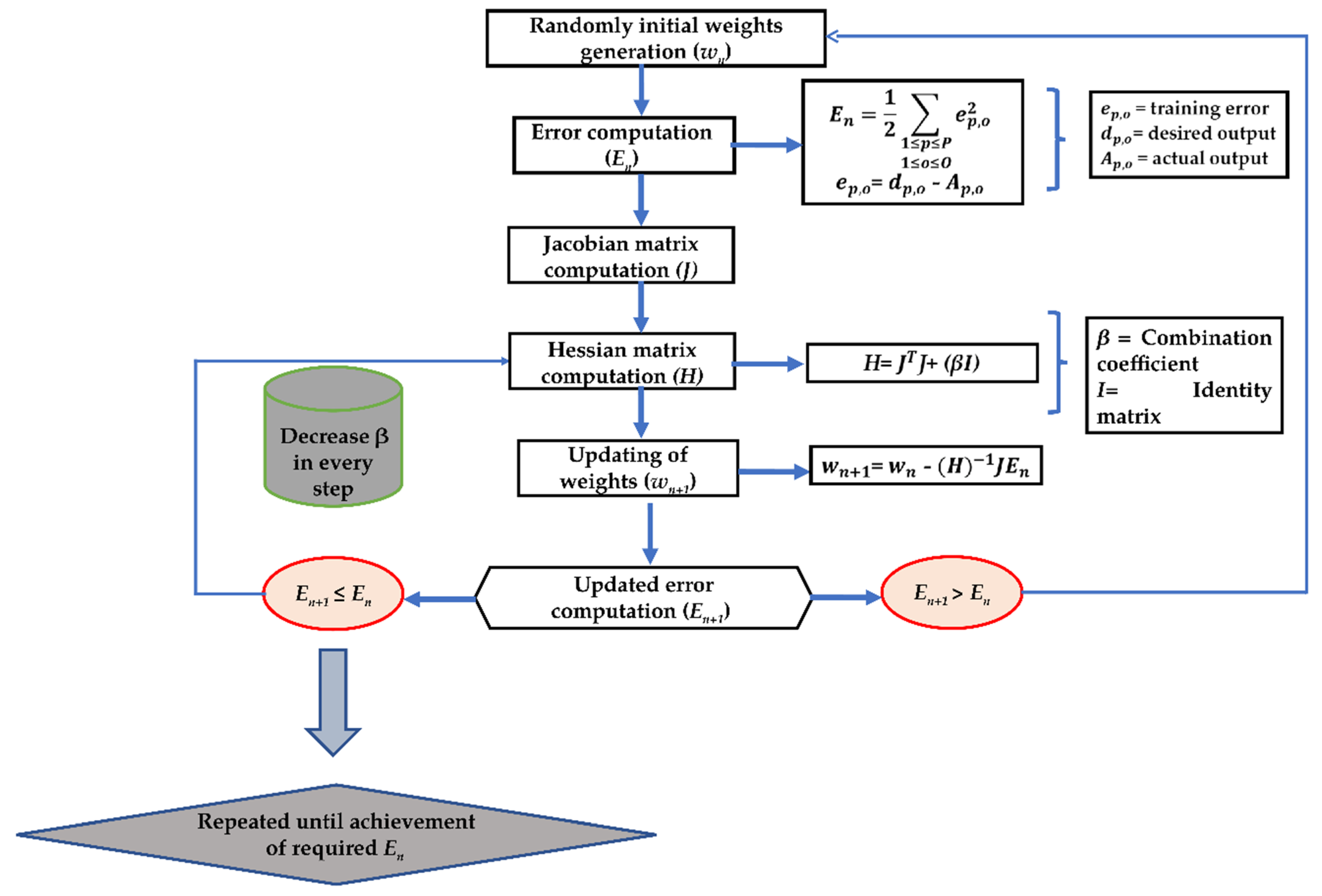
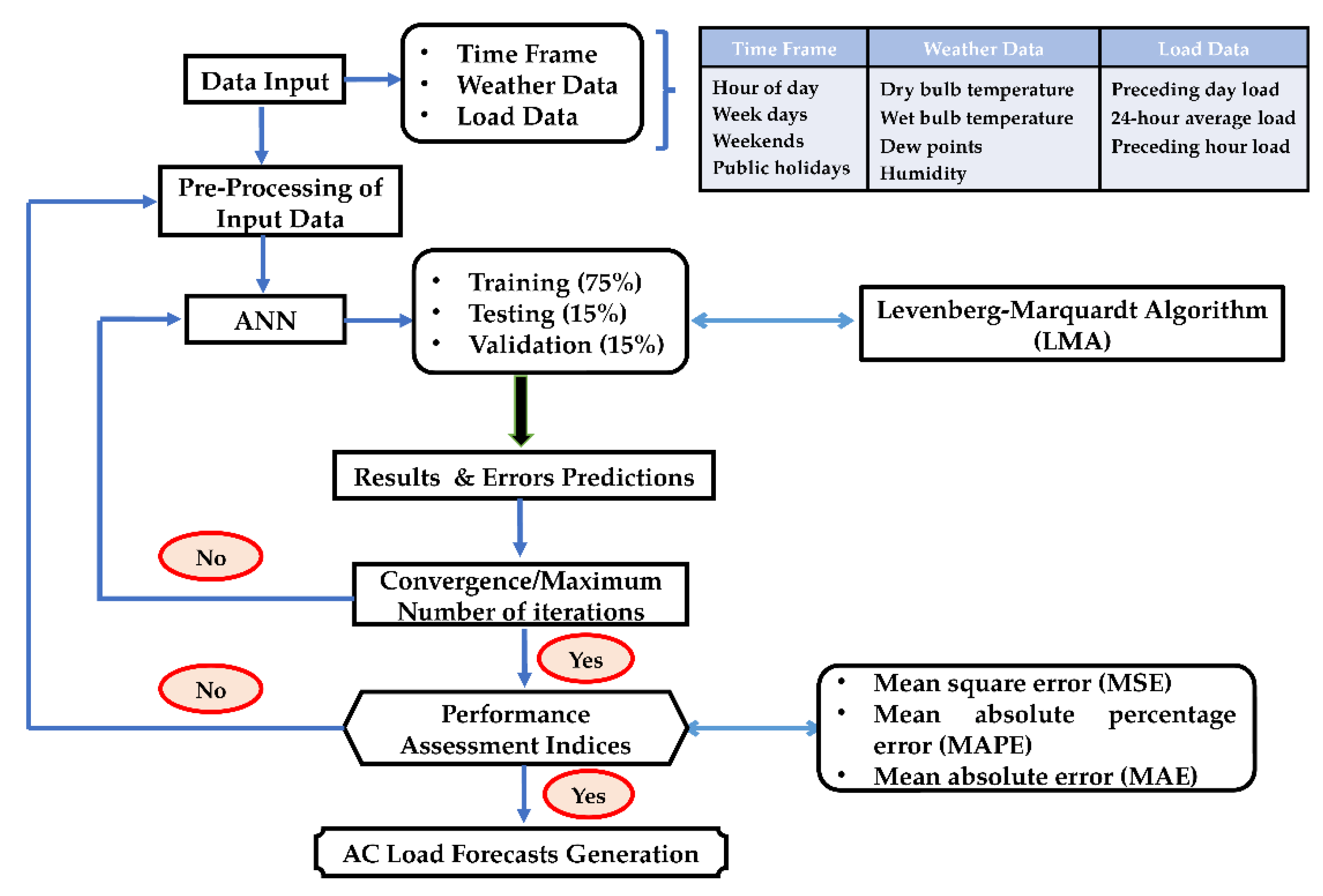

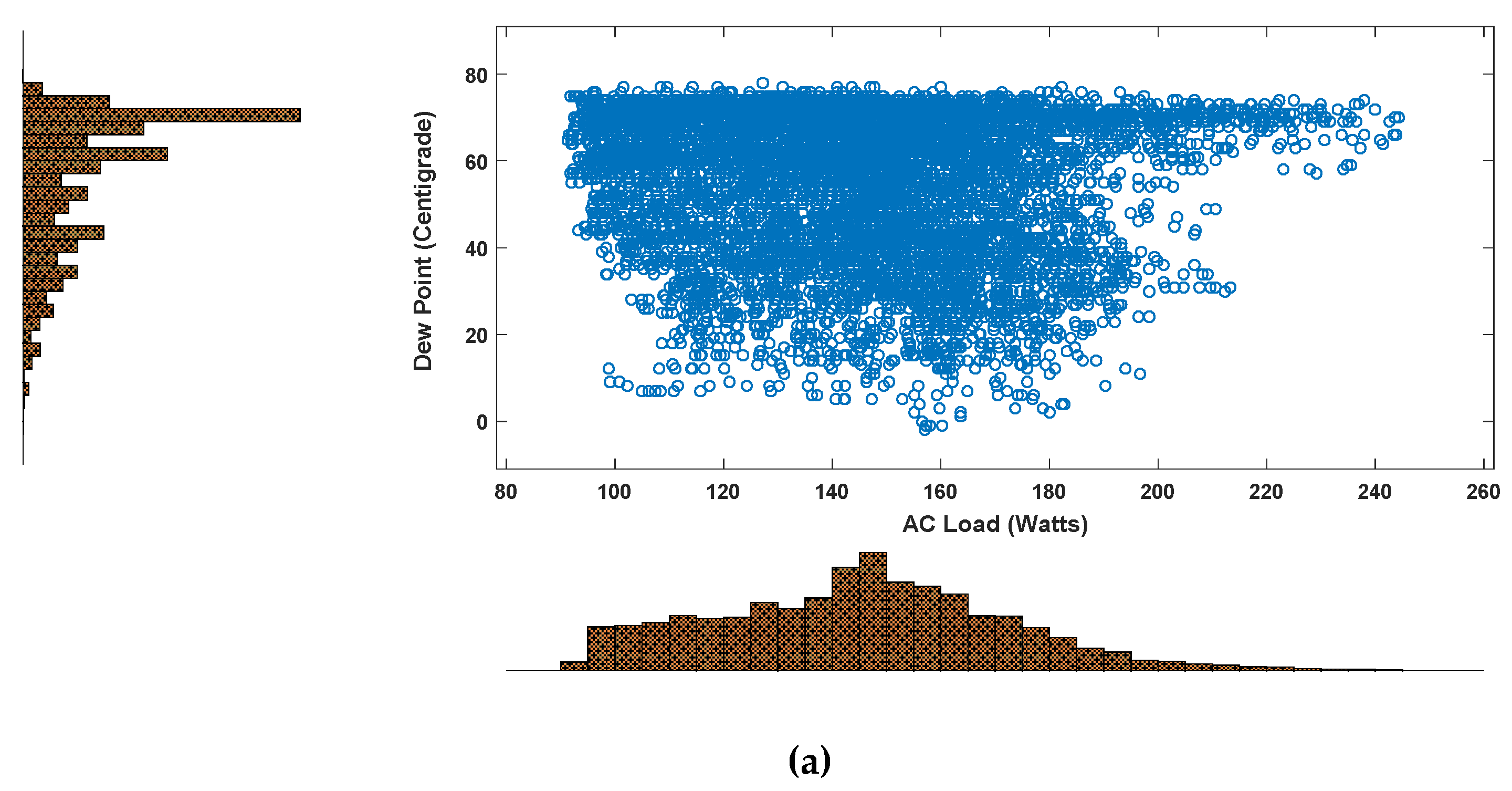

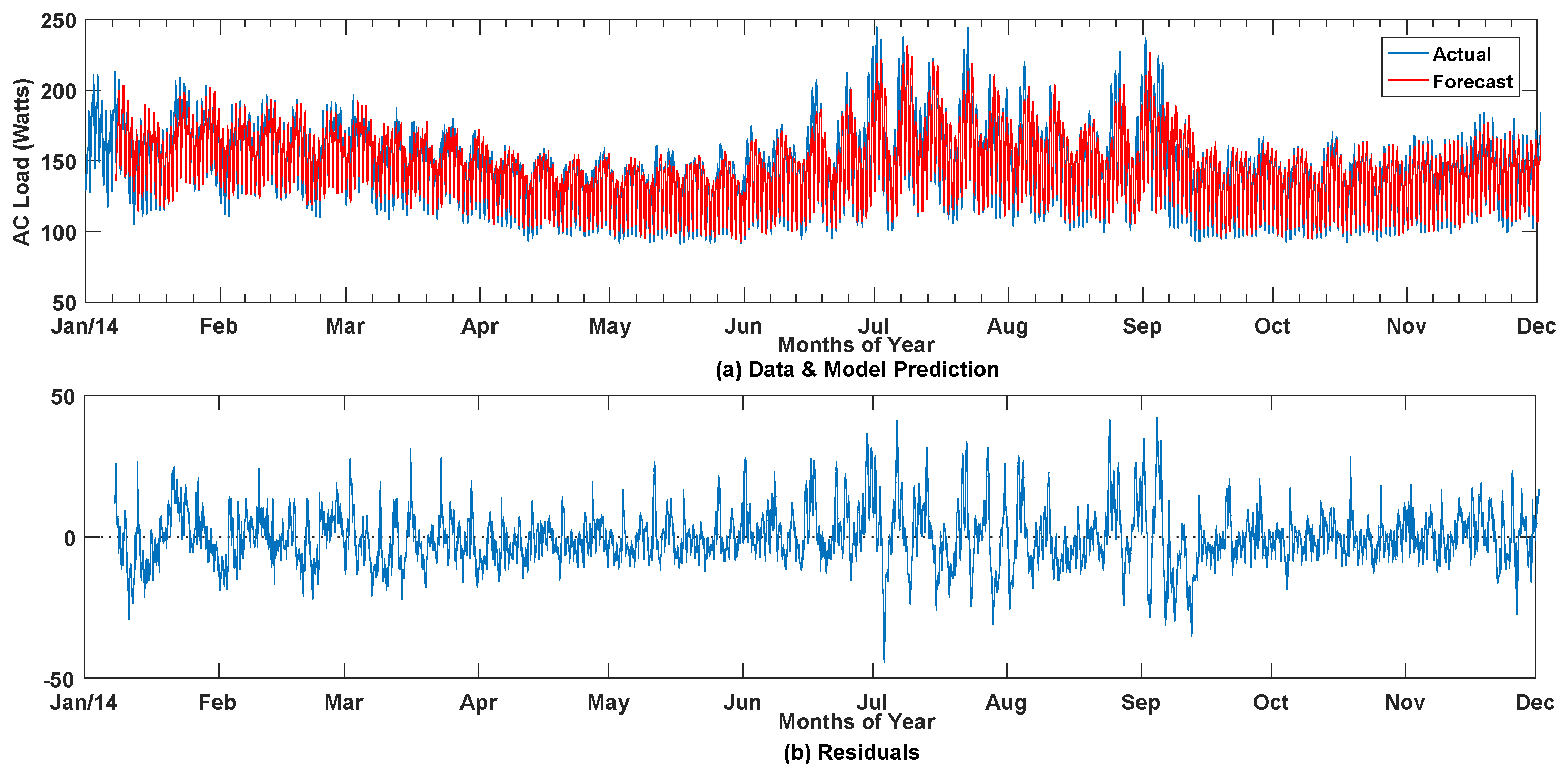
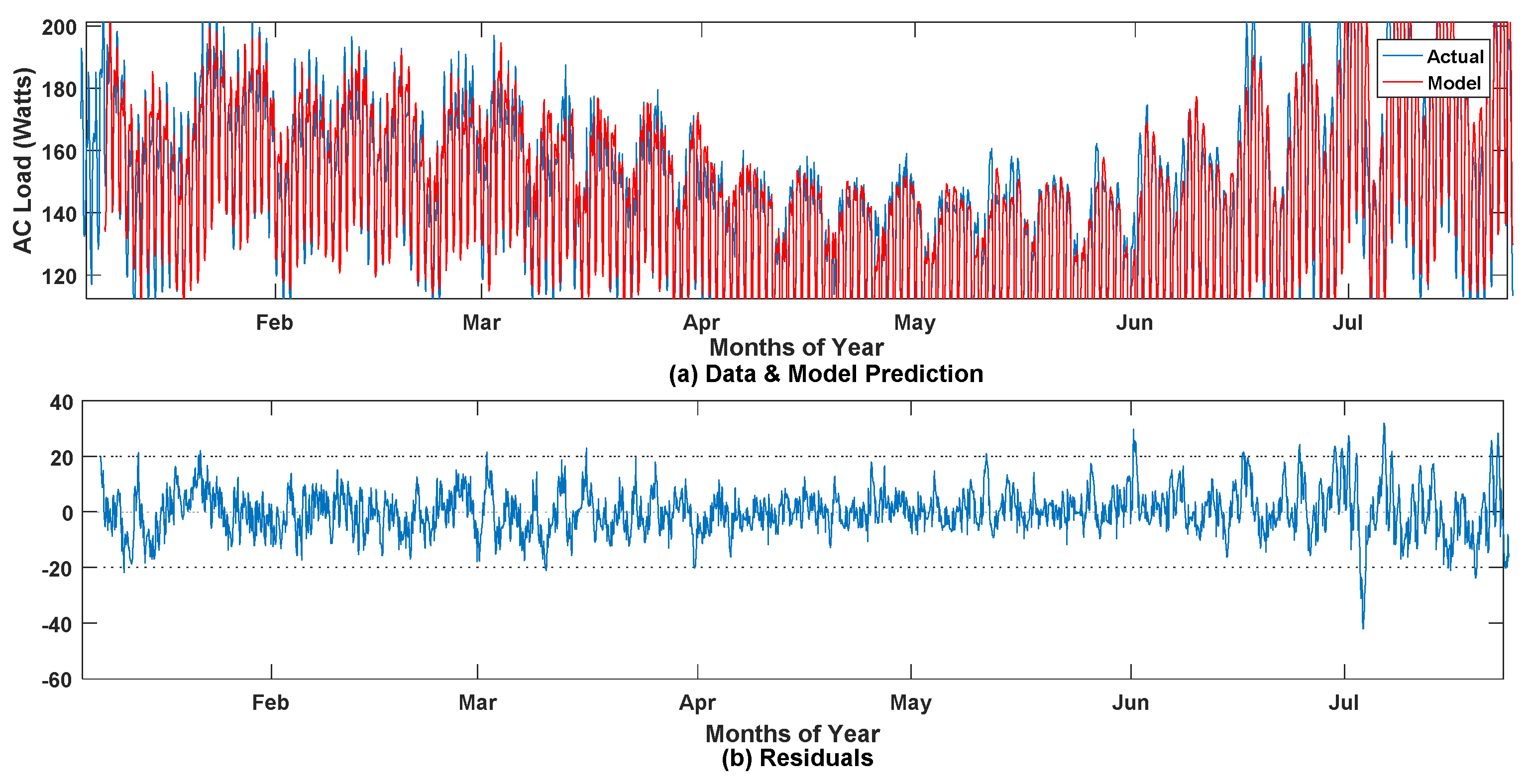
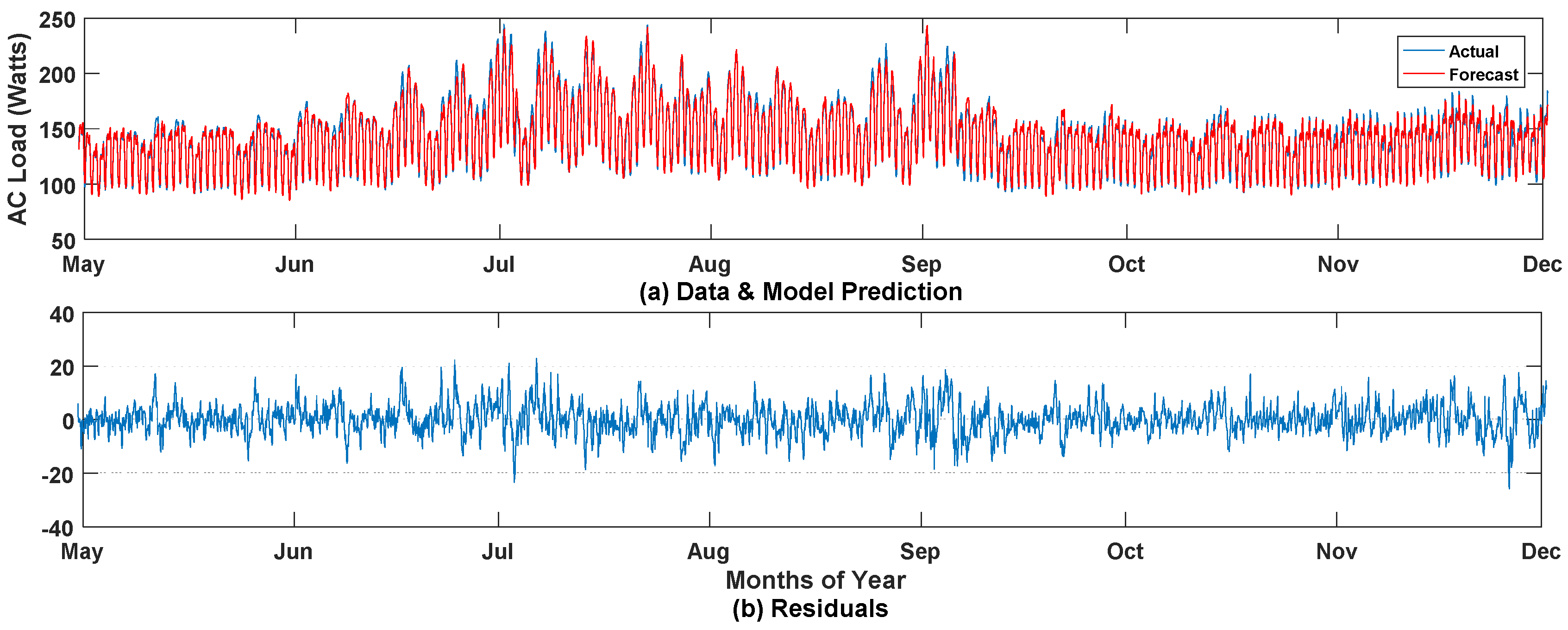
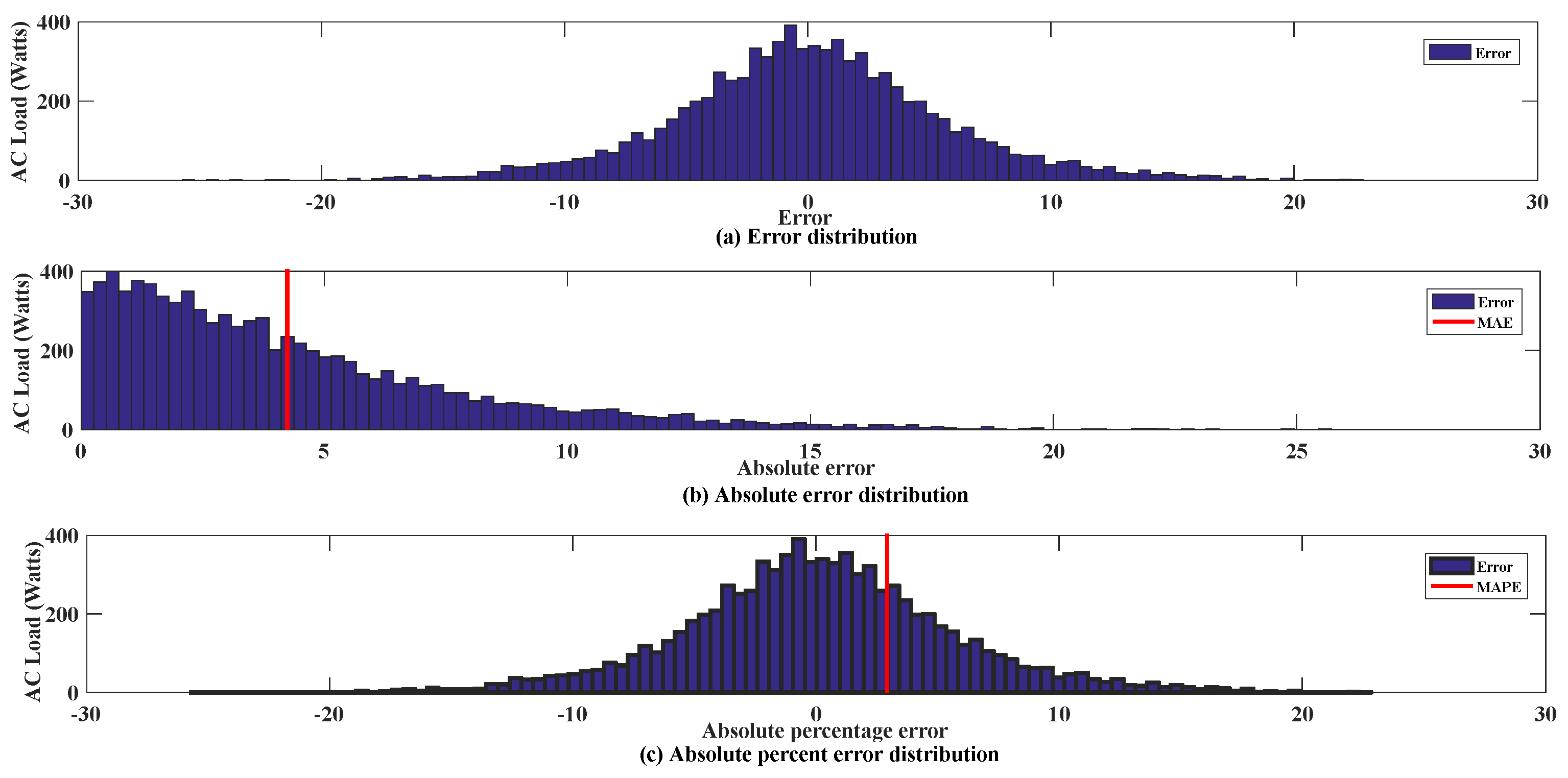
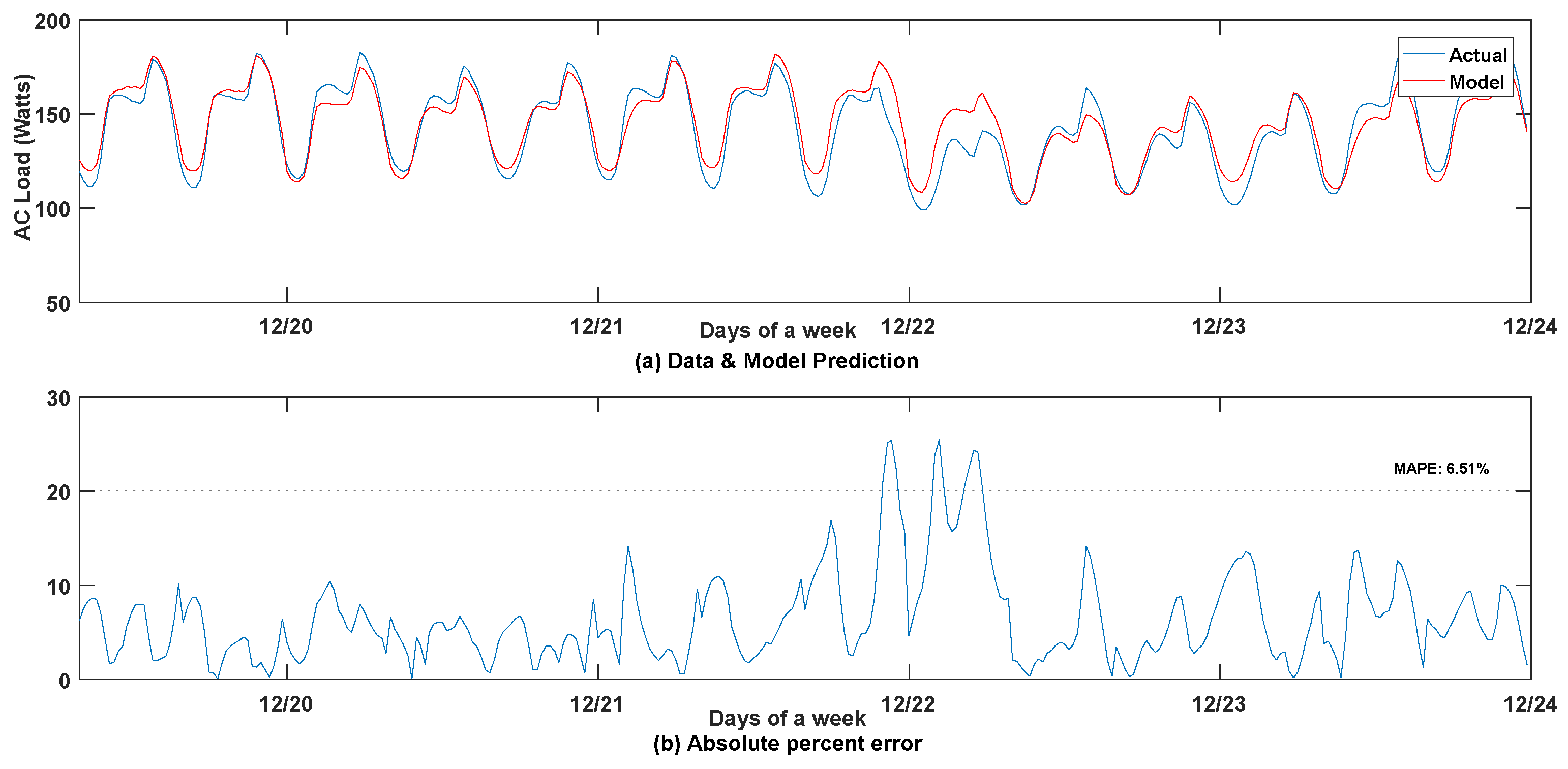
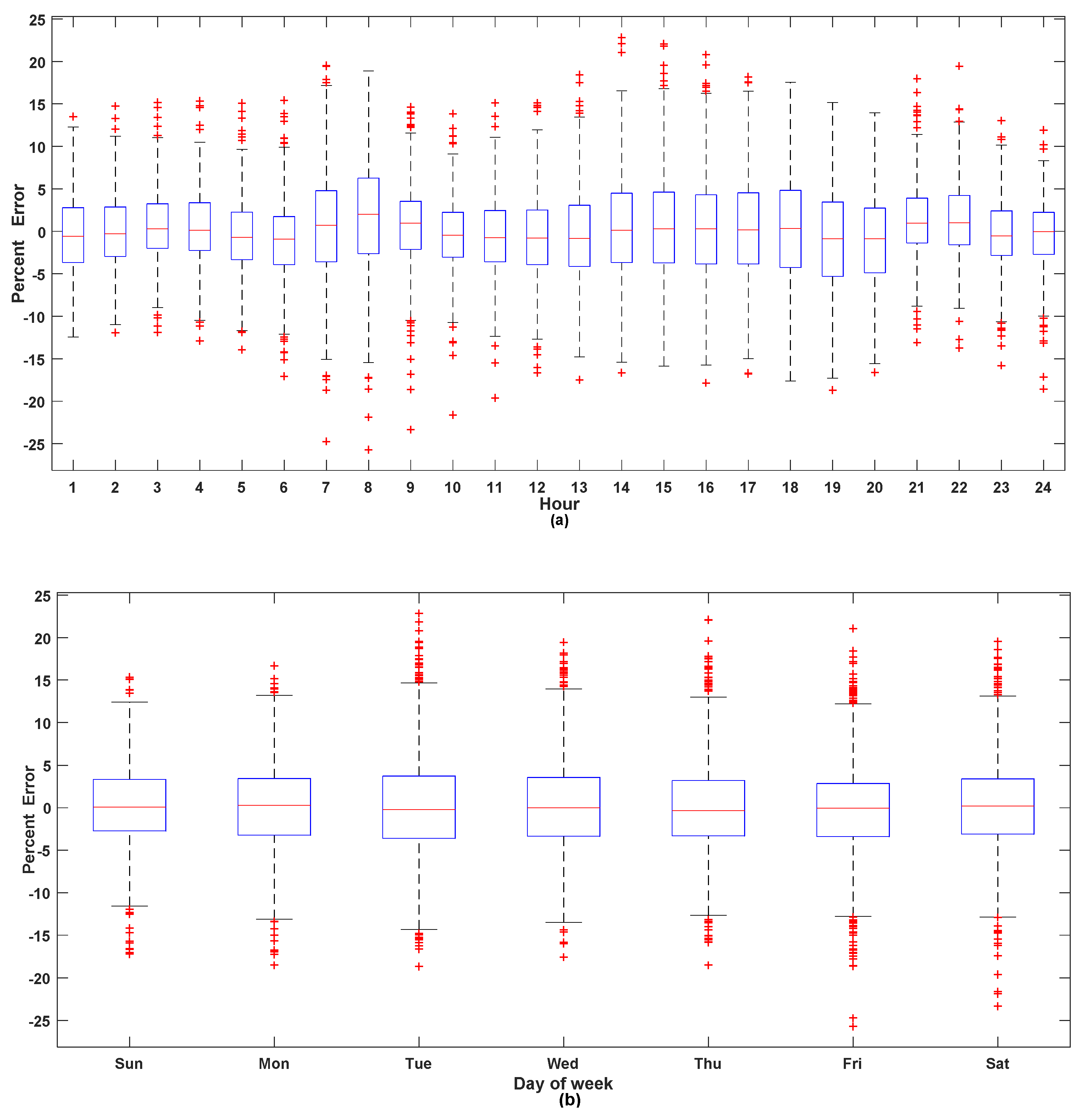
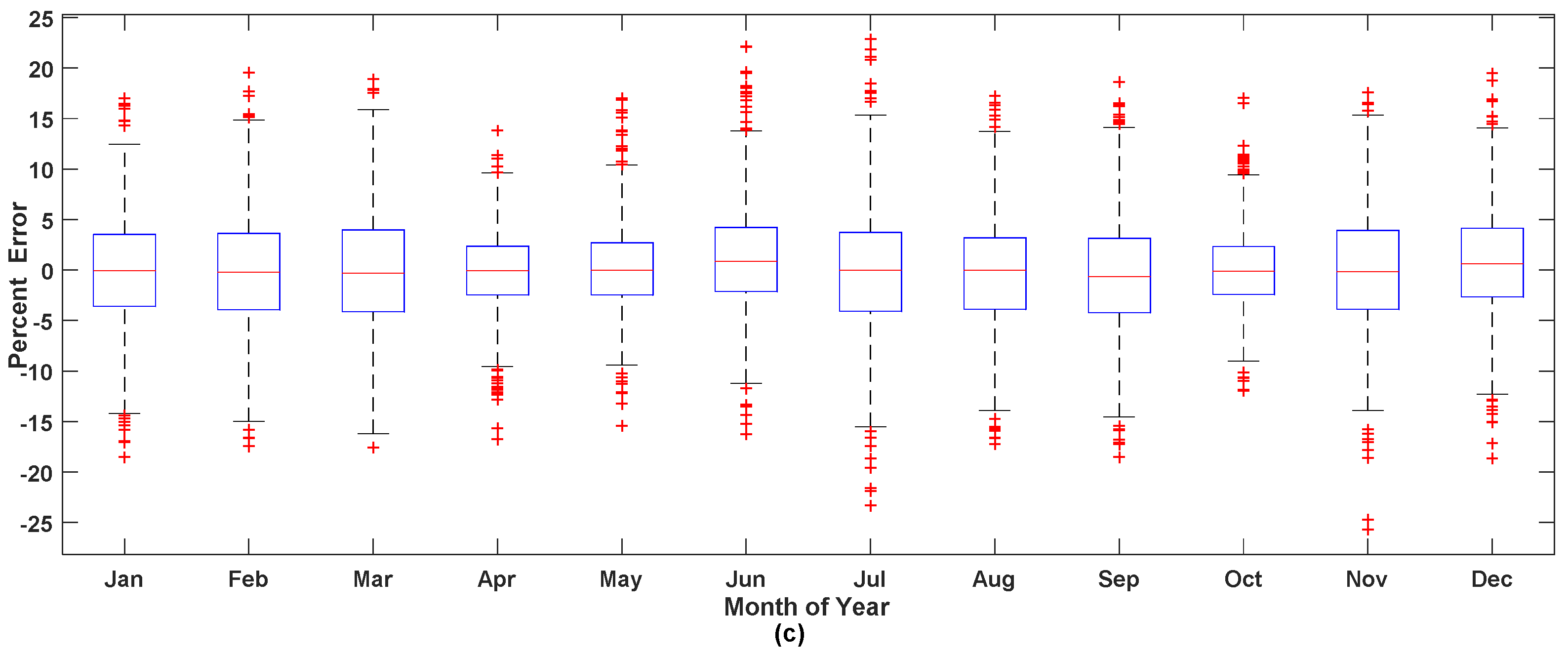
| LF Approach | Prediction Horizon | Achievable Benefits | Influencing Factors |
|---|---|---|---|
| Very Short-Term |
|
|
|
| Short-Term |
|
| |
| Medium-Term |
|
|
|
| Long-Term |
|
|
|
| Very Long-Term |
|
|
| Multiple Linear Regression | SCG-Based ANN | LMA-Based ANN | |||||
|---|---|---|---|---|---|---|---|
| Hour | Actual | Predicted | %AE | Predicted | %AE | Predicted | %AE |
| 1 | 129.60 | 144.31 | 5.26 | 131.49 | 1.46 | 136.41 | 5.26 |
| 2 | 124.27 | 141.02 | 5.65 | 131.29 | 5.65 | 131.29 | 5.65 |
| 3 | 120.89 | 139.27 | 6.12 | 131.78 | 9.01 | 128.29 | 6.12 |
| 4 | 119.48 | 139.07 | 7.13 | 133.15 | 11.44 | 128.00 | 7.13 |
| 5 | 119.96 | 141.09 | 8.98 | 135.88 | 13.27 | 130.73 | 8.98 |
| 6 | 123.18 | 147.60 | 11.51 | 141.03 | 14.49 | 137.35 | 11.51 |
| 7 | 129.91 | 159.20 | 13.14 | 148.64 | 14.42 | 146.98 | 13.14 |
| 8 | 138.11 | 166.99 | 10.66 | 154.49 | 11.86 | 152.84 | 10.66 |
| 9 | 147.38 | 170.49 | 5.74 | 158.07 | 7.25 | 155.85 | 5.74 |
| 10 | 155.07 | 172.81 | 1.25 | 160.52 | 3.52 | 157.01 | 1.25 |
| 11 | 159.14 | 173.72 | 1.54 | 161.90 | 1.73 | 156.69 | 1.54 |
| 12 | 160.29 | 172.65 | 2.66 | 162.31 | 1.26 | 156.02 | 2.66 |
| 13 | 159.40 | 170.55 | 2.62 | 162.10 | 1.69 | 155.23 | 2.62 |
| 14 | 157.09 | 168.46 | 1.39 | 161.77 | 2.98 | 154.90 | 1.39 |
| 15 | 154.99 | 165.95 | 0.28 | 161.18 | 3.99 | 155.43 | 0.28 |
| 16 | 155.96 | 165.71 | 1.54 | 161.07 | 3.27 | 158.36 | 1.54 |
| 17 | 162.86 | 172.54 | 1.09 | 163.30 | 0.27 | 164.64 | 1.09 |
| 18 | 167.66 | 180.35 | 0.07 | 165.67 | 1.19 | 167.78 | 0.07 |
| 19 | 164.53 | 178.28 | 1.89 | 164.33 | 0.12 | 167.64 | 1.89 |
| 20 | 158.47 | 173.62 | 3.92 | 162.05 | 2.26 | 164.68 | 3.92 |
| 21 | 152.15 | 168.57 | 4.23 | 159.26 | 4.67 | 158.59 | 4.23 |
| 22 | 143.47 | 161.65 | 4.97 | 154.34 | 7.58 | 150.60 | 4.97 |
| 23 | 134.31 | 152.91 | 5.01 | 147.31 | 9.68 | 141.04 | 5.01 |
| 24 | 124.61 | 143.29 | 4.73 | 138.69 | 11.30 | 130.50 | 4.73 |
| Maximum | 180.35 | 22.54 | 165.67 | 14.49 | 167.78 | 13.14 | |
| MSE % | 9.68 | 8.30 | 5.57 | ||||
| MAPE % | 4.9529 | 4.2782 | 2.9221 | ||||
| MAE(Wh) | 7.2294 | 6.2456 | 4.2371 | ||||
| Daily MAPE % | 4.3743 | 4.1249 | 2.5348 | ||||
© 2019 by the authors. Licensee MDPI, Basel, Switzerland. This article is an open access article distributed under the terms and conditions of the Creative Commons Attribution (CC BY) license (http://creativecommons.org/licenses/by/4.0/).
Share and Cite
Waseem, M.; Lin, Z.; Yang, L. Data-Driven Load Forecasting of Air Conditioners for Demand Response Using Levenberg–Marquardt Algorithm-Based ANN. Big Data Cogn. Comput. 2019, 3, 36. https://doi.org/10.3390/bdcc3030036
Waseem M, Lin Z, Yang L. Data-Driven Load Forecasting of Air Conditioners for Demand Response Using Levenberg–Marquardt Algorithm-Based ANN. Big Data and Cognitive Computing. 2019; 3(3):36. https://doi.org/10.3390/bdcc3030036
Chicago/Turabian StyleWaseem, Muhammad, Zhenzhi Lin, and Li Yang. 2019. "Data-Driven Load Forecasting of Air Conditioners for Demand Response Using Levenberg–Marquardt Algorithm-Based ANN" Big Data and Cognitive Computing 3, no. 3: 36. https://doi.org/10.3390/bdcc3030036
APA StyleWaseem, M., Lin, Z., & Yang, L. (2019). Data-Driven Load Forecasting of Air Conditioners for Demand Response Using Levenberg–Marquardt Algorithm-Based ANN. Big Data and Cognitive Computing, 3(3), 36. https://doi.org/10.3390/bdcc3030036







